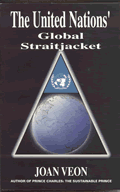Other
Veon
Articles:
US Leaders Highlight World Economic Forum Agenda
Global Taxation And Tax Harmonization
Does The
Global Economy Need a Global Currency?
GLOBAL TAXATION REARS ITS UGLY HEAD
By
Joan Veon
May 2, 2004
NewsWithViews.com
It was ten years ago this year that I read a newsletter put out by a group founded by Bella Abzug, The Women's Environment and Development Organization-WEDO, that told of the UN's plans to present the idea of global taxation at the UN Social Summit in March, 1995. At that meeting, Ms. Abzug, along with Dr. Inga Kaul, a key official from the United Nations Development Programme, held a special day long press briefing in which they presented their ideas. I asked Dr. Kaul why the people of the world should allow global taxation since the various methods they were suggesting would provide the UN with over $1.646T when their 1993 budget was $10.5B. Very flustered, she replied, "They�deserve it�and they would have monies left over to help countries."
Since that time, I have monitored and followed the concept of global taxation. In order to have a global tax, which comprises the highest form of transfer of wealth, you need really good reasons. At the Millennium Summit in 2000, the UN presented the world's 189 kings, princes, prime ministers and presidents a list of global needs. They include by 2015: reducing poverty and hunger by 50%, ensuring that children everywhere are able to complete a full course of primary schooling, reducing by 66% child mortality, halting and reversing HIV/AIDS, malaria and other major diseases and improving the lives of 100 million slum dwellers, among others.
Notice that this is not a country by country goal, which would reflect the idea of national sovereignty but reflects a world united and governed through a universal political body called the United Nations. These goals have also been adopted by all of the extended UN family: the International Monetary Fund/World Bank, the World Health Organization, UNESCO, etc. as well as the Group of Eight heads of state. Many leading multinational and transnational corporations have also adopted these goals. It is only you and I who have not been told-probably because we would not agree with it.
As such, the primary focus of the Spring Meeting of the IMF/World Bank that just concluded was how to meet and finance the UN Millennium Development Goals. The UN estimates another $50B per year is needed. The Development Committee which is comprised of key officials from both the IMF and World Bank, including U.S. Treasury Secretary John Snow, issued a report on how to increase funding which includes: (1) increase Overseas Development Assistance-ODA, (2) set up a proposed International Financing Facility, (3) global taxation and (4) increase in aid.
It should be noted that all of these suggestions have been around for awhile. In 1994, the United Nations Development Programme issued the Human Development Report which basically outlined the same ideas that are now being discussed. The difference is instead of them being conceptual, as they may have been then, today they are being seriously discussed by country governments and are now showing up at the IMF/World Bank level and the G7 Finance Ministers and G8 heads of government levels.
Let us take a look at each of these. (1) Increase Overseas Development Assistance-ODA. To prepare for the Financing for Development Meeting in Monterrey, Mexico in 2002, George Bush doubled the amount of ODA from $10B to $15B beginning this year. The UN target is .07% of Gross National Income. The U.S. as well as most of the developed countries, are giving an average of 0.23%. ODA is used for debt relief, technical cooperation, and emergency and disaster relief along with food aid and totals $6B a year.
(2) The proposed International Financing Facility. The 1994 Human Development Report recommended that an International Investment Trust be set up. The proposed International Financing Facility would be a temporary financing mechanism that would hold the annual payments from donor countries as well as issue AAA-rated bonds based on the future donor pledges of countries. In other words, it would securitize (issue bonds) future pledges in ODA through the bond market. The bond proceeds would be channeled through existing aid programs. This proposal has already been widely discussed within the G8, EU, UN, the IMF and World Bank as a result of being presented at the September 2003 annual IMF/World Bank meeting in Dubai. The specific mechanics as to how to set up the Facility is still under discussion.
(3) Global Taxation. In the 1994 Human Development Report, it recommended five different sources of taxation: possible tax on arms trade, a global tax of $1 per barrel on oil consumption, assessing a tax of 0.05% on the value of each international currency transaction, Special Drawing Rights, and a world income tax of 0.1% on the richest nations. The current Global Taxation Proposals include: environmental taxes of various kinds-most prominently a carbon tax or a system of tradable permits (the U.S. has established the first carbon permit trading exchange with other European countries now following suit), a tax on foreign exchange at the rate of 0.02% (many experts say that there are many barriers), increase taxes on aviation fuel and/or air transport, on shipping or arms exports, taxing resources held in the global commons such as the mining rights in international waters (Law of the Sea-the U.S. is to hold hearings on ratifying the Law of the Sea Treaty), create and voluntarily redistribute additional Special Drawing Rights (SDR's), and other ideas such as a global lottery.
In the final IMF/World Bank press briefing, I asked key officials that included World Bank President Jim Wolfensohn if they could tell me which global tax mechanism was preferred and what kind of timing did they foresee. I was told that "this was a very complex issue." Lastly, an increase in aid is always welcomed.
It should be noted that you always need the poor to justify a transfer of wealth. Interestingly enough many of the very poor and highly indebted poor countries are rich in minerals such as gold. However, most of the income from mining minerals goes to pay the World Bank back for loans made to most of these third world countries. Back in the 1970s and 80s, the World Bank made specific project loans to these countries to help them make money by selling electricity from hydro-electric dams, and other high capital investment projects. Unfortunately more than 80% of these projects never panned out but became the huge debt burden which these countries have.
Perhaps it is time to put an end
to all of the schematic transfer of wealth mechanisms and withdraw
not only from the UN, but the IMF, the World Bank, the World Health
Organization, UNESCO, the International Criminal Court, the World
Trade Organization and all of the rest of the alphabet soup organizations
that have taken our sovereignty and are now calling for additional
transfer of wealth schemes!
� 2004 Joan Veon - All Rights Reserved
Sign
Up For Free E-Mail Alerts
 Order
Joan Veon's book
Order
Joan Veon's book
"The
United Nations'
Global Straitjacket"
Joan Veon is a businesswoman and independent
international reporter. Please visit her website: www.womensgroup.org.
To get a copy of her WTO report, send $10.00 to The Women's International
Media Group, Inc. P. O. Box 77, Middletown, MD 21769. For an information
packet, please call 301-371-0541
"Perhaps it is time to put an end to all of the schematic transfer of wealth mechanisms and withdraw not only from the UN, but the IMF, the World Bank, the World Health Organization, UNESCO..."







